Xiaokang Liu
DiffSim: Taming Diffusion Models for Evaluating Visual Similarity
Dec 19, 2024



Abstract:Diffusion models have fundamentally transformed the field of generative models, making the assessment of similarity between customized model outputs and reference inputs critically important. However, traditional perceptual similarity metrics operate primarily at the pixel and patch levels, comparing low-level colors and textures but failing to capture mid-level similarities and differences in image layout, object pose, and semantic content. Contrastive learning-based CLIP and self-supervised learning-based DINO are often used to measure semantic similarity, but they highly compress image features, inadequately assessing appearance details. This paper is the first to discover that pretrained diffusion models can be utilized for measuring visual similarity and introduces the DiffSim method, addressing the limitations of traditional metrics in capturing perceptual consistency in custom generation tasks. By aligning features in the attention layers of the denoising U-Net, DiffSim evaluates both appearance and style similarity, showing superior alignment with human visual preferences. Additionally, we introduce the Sref and IP benchmarks to evaluate visual similarity at the level of style and instance, respectively. Comprehensive evaluations across multiple benchmarks demonstrate that DiffSim achieves state-of-the-art performance, providing a robust tool for measuring visual coherence in generative models.
Anti-Reference: Universal and Immediate Defense Against Reference-Based Generation
Dec 08, 2024Abstract:Diffusion models have revolutionized generative modeling with their exceptional ability to produce high-fidelity images. However, misuse of such potent tools can lead to the creation of fake news or disturbing content targeting individuals, resulting in significant social harm. In this paper, we introduce Anti-Reference, a novel method that protects images from the threats posed by reference-based generation techniques by adding imperceptible adversarial noise to the images. We propose a unified loss function that enables joint attacks on fine-tuning-based customization methods, non-fine-tuning customization methods, and human-centric driving methods. Based on this loss, we train a Adversarial Noise Encoder to predict the noise or directly optimize the noise using the PGD method. Our method shows certain transfer attack capabilities, effectively challenging both gray-box models and some commercial APIs. Extensive experiments validate the performance of Anti-Reference, establishing a new benchmark in image security.
An End-To-End Stuttering Detection Method Based On Conformer And BILSTM
Nov 14, 2024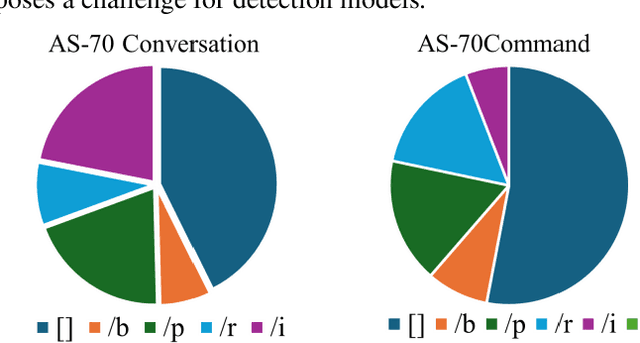

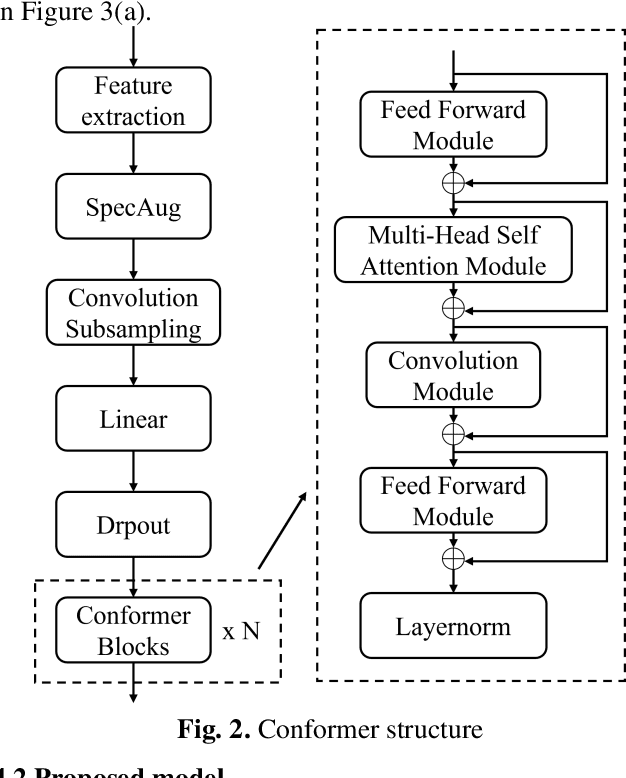

Abstract:Stuttering is a neurodevelopmental speech disorder characterized by common speech symptoms such as pauses, exclamations, repetition, and prolongation. Speech-language pathologists typically assess the type and severity of stuttering by observing these symptoms. Many effective end-to-end methods exist for stuttering detection, but a commonly overlooked challenge is the uncertain relationship between tasks involved in this process. Using a suitable multi-task strategy could improve stuttering detection performance. This paper presents a novel stuttering event detection model designed to help speech-language pathologists assess both the type and severity of stuttering. First, the Conformer model extracts acoustic features from stuttered speech, followed by a Long Short-Term Memory (LSTM) network to capture contextual information. Finally, we explore multi-task learning for stuttering and propose an effective multi-task strategy. Experimental results show that our model outperforms current state-of-the-art methods for stuttering detection. In the SLT 2024 Stuttering Speech Challenge based on the AS-70 dataset [1], our model improved the mean F1 score by 24.8% compared to the baseline method and achieved first place. On this basis, we conducted relevant extensive experiments on LSTM and multi-task learning strategies respectively. The results show that our proposed method improved the mean F1 score by 39.8% compared to the baseline method.
Automatic Assessment of Dysarthria Using Audio-visual Vowel Graph Attention Network
May 07, 2024



Abstract:Automatic assessment of dysarthria remains a highly challenging task due to high variability in acoustic signals and the limited data. Currently, research on the automatic assessment of dysarthria primarily focuses on two approaches: one that utilizes expert features combined with machine learning, and the other that employs data-driven deep learning methods to extract representations. Research has demonstrated that expert features are effective in representing pathological characteristics, while deep learning methods excel at uncovering latent features. Therefore, integrating the advantages of expert features and deep learning to construct a neural network architecture based on expert knowledge may be beneficial for interpretability and assessment performance. In this context, the present paper proposes a vowel graph attention network based on audio-visual information, which effectively integrates the strengths of expert knowledges and deep learning. Firstly, various features were combined as inputs, including knowledge based acoustical features and deep learning based pre-trained representations. Secondly, the graph network structure based on vowel space theory was designed, allowing for a deep exploration of spatial correlations among vowels. Finally, visual information was incorporated into the model to further enhance its robustness and generalizability. The method exhibited superior performance in regression experiments targeting Frenchay scores compared to existing approaches.
Unleashing the Power of Multi-Task Learning: A Comprehensive Survey Spanning Traditional, Deep, and Pretrained Foundation Model Eras
Apr 29, 2024



Abstract:MTL is a learning paradigm that effectively leverages both task-specific and shared information to address multiple related tasks simultaneously. In contrast to STL, MTL offers a suite of benefits that enhance both the training process and the inference efficiency. MTL's key advantages encompass streamlined model architecture, performance enhancement, and cross-domain generalizability. Over the past twenty years, MTL has become widely recognized as a flexible and effective approach in various fields, including CV, NLP, recommendation systems, disease prognosis and diagnosis, and robotics. This survey provides a comprehensive overview of the evolution of MTL, encompassing the technical aspects of cutting-edge methods from traditional approaches to deep learning and the latest trend of pretrained foundation models. Our survey methodically categorizes MTL techniques into five key areas: regularization, relationship learning, feature propagation, optimization, and pre-training. This categorization not only chronologically outlines the development of MTL but also dives into various specialized strategies within each category. Furthermore, the survey reveals how the MTL evolves from handling a fixed set of tasks to embracing a more flexible approach free from task or modality constraints. It explores the concepts of task-promptable and -agnostic training, along with the capacity for ZSL, which unleashes the untapped potential of this historically coveted learning paradigm. Overall, we hope this survey provides the research community with a comprehensive overview of the advancements in MTL from its inception in 1997 to the present in 2023. We address present challenges and look ahead to future possibilities, shedding light on the opportunities and potential avenues for MTL research in a broad manner. This project is publicly available at https://github.com/junfish/Awesome-Multitask-Learning.
An Audio-textual Diffusion Model For Converting Speech Signals Into Ultrasound Tongue Imaging Data
Mar 12, 2024


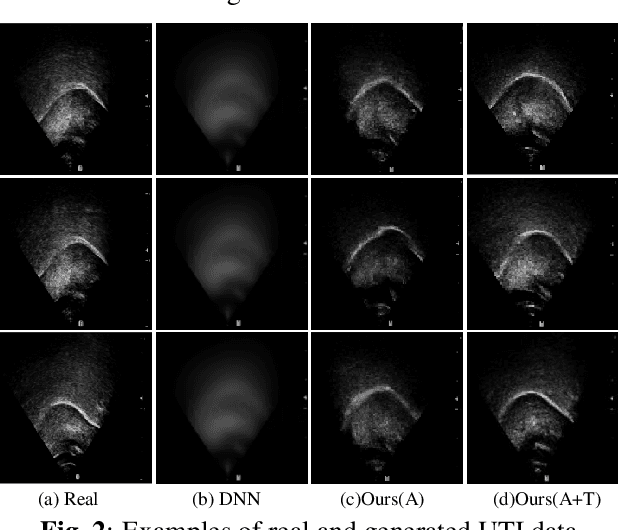
Abstract:Acoustic-to-articulatory inversion (AAI) is to convert audio into articulator movements, such as ultrasound tongue imaging (UTI) data. An issue of existing AAI methods is only using the personalized acoustic information to derive the general patterns of tongue motions, and thus the quality of generated UTI data is limited. To address this issue, this paper proposes an audio-textual diffusion model for the UTI data generation task. In this model, the inherent acoustic characteristics of individuals related to the tongue motion details are encoded by using wav2vec 2.0, while the ASR transcriptions related to the universality of tongue motions are encoded by using BERT. UTI data are then generated by using a diffusion module. Experimental results showed that the proposed diffusion model could generate high-quality UTI data with clear tongue contour that is crucial for the linguistic analysis and clinical assessment. The project can be found on the website\footnote{https://yangyudong2020.github.io/wav2uti/
Effective Open Intent Classification with K-center Contrastive Learning and Adjustable Decision Boundary
Apr 20, 2023Abstract:Open intent classification, which aims to correctly classify the known intents into their corresponding classes while identifying the new unknown (open) intents, is an essential but challenging task in dialogue systems. In this paper, we introduce novel K-center contrastive learning and adjustable decision boundary learning (CLAB) to improve the effectiveness of open intent classification. First, we pre-train a feature encoder on the labeled training instances, which transfers knowledge from known intents to unknown intents. Specifically, we devise a K-center contrastive learning algorithm to learn discriminative and balanced intent features, improving the generalization of the model for recognizing open intents. Second, we devise an adjustable decision boundary learning method with expanding and shrinking (ADBES) to determine the suitable decision conditions. Concretely, we learn a decision boundary for each known intent class, which consists of a decision center and the radius of the decision boundary. We then expand the radius of the decision boundary to accommodate more in-class instances if the out-of-class instances are far from the decision boundary; otherwise, we shrink the radius of the decision boundary. Extensive experiments on three benchmark datasets clearly demonstrate the effectiveness of our method for open intent classification. For reproducibility, we submit the code at: https://github.com/lxk00/CLAP
Schema Inference for Interpretable Image Classification
Mar 12, 2023Abstract:In this paper, we study a novel inference paradigm, termed as schema inference, that learns to deductively infer the explainable predictions by rebuilding the prior deep neural network (DNN) forwarding scheme, guided by the prevalent philosophical cognitive concept of schema. We strive to reformulate the conventional model inference pipeline into a graph matching policy that associates the extracted visual concepts of an image with the pre-computed scene impression, by analogy with human reasoning mechanism via impression matching. To this end, we devise an elaborated architecture, termed as SchemaNet, as a dedicated instantiation of the proposed schema inference concept, that models both the visual semantics of input instances and the learned abstract imaginations of target categories as topological relational graphs. Meanwhile, to capture and leverage the compositional contributions of visual semantics in a global view, we also introduce a universal Feat2Graph scheme in SchemaNet to establish the relational graphs that contain abundant interaction information. Both the theoretical analysis and the experimental results on several benchmarks demonstrate that the proposed schema inference achieves encouraging performance and meanwhile yields a clear picture of the deductive process leading to the predictions. Our code is available at https://github.com/zhfeing/SchemaNet-PyTorch.
Can Language Models Make Fun? A Case Study in Chinese Comical Crosstalk
Jul 02, 2022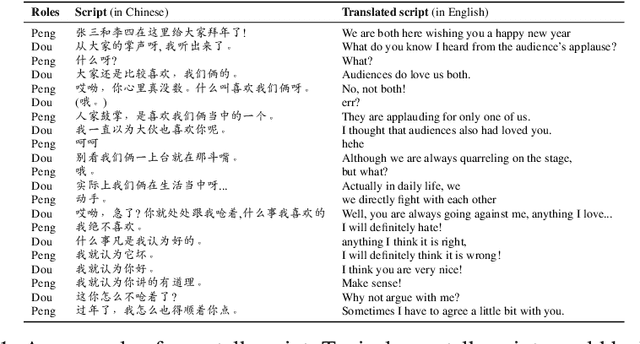
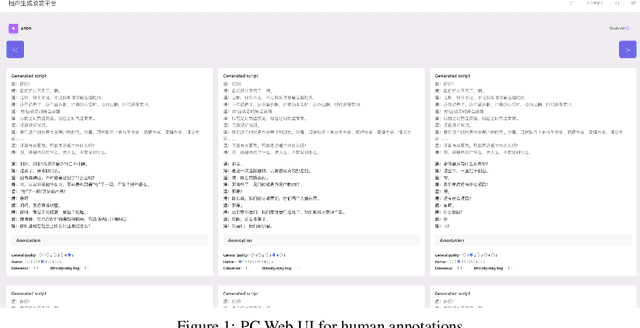
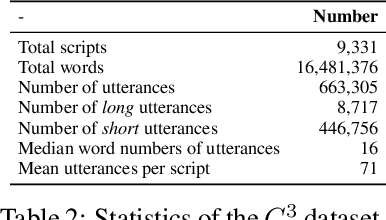
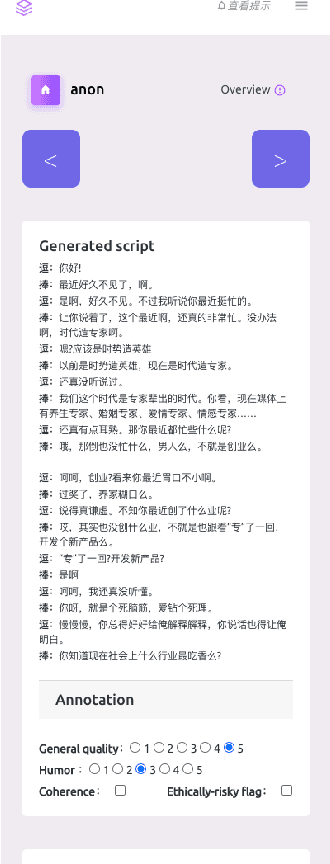
Abstract:Language is the principal tool for human communication, in which humor is one of the most attractive parts. Producing natural language like humans using computers, a.k.a, Natural Language Generation (NLG), has been widely used for dialogue systems, chatbots, machine translation, as well as computer-aid creation e.g., idea generations, scriptwriting. However, the humor aspect of natural language is relatively under-investigated, especially in the age of pre-trained language models. In this work, we aim to preliminarily test whether NLG can generate humor as humans do. We build a new dataset consisting of numerous digitized Chinese Comical Crosstalk scripts (called C$^3$ in short), which is for a popular Chinese performing art called `Xiangsheng' since 1800s. (For convenience for non-Chinese speakers, we called `crosstalk' for `Xiangsheng' in this paper.) We benchmark various generation approaches including training-from-scratch Seq2seq, fine-tuned middle-scale PLMs, and large-scale PLMs (with and without fine-tuning). Moreover, we also conduct a human assessment, showing that 1) large-scale pretraining largely improves crosstalk generation quality; and 2) even the scripts generated from the best PLM is far from what we expect, with only 65% quality of human-created crosstalk. We conclude, humor generation could be largely improved using large-scaled PLMs, but it is still in its infancy. The data and benchmarking code is publicly available in \url{https://github.com/anonNo2/crosstalk-generation}.
BERT-EMD: Many-to-Many Layer Mapping for BERT Compression with Earth Mover's Distance
Oct 13, 2020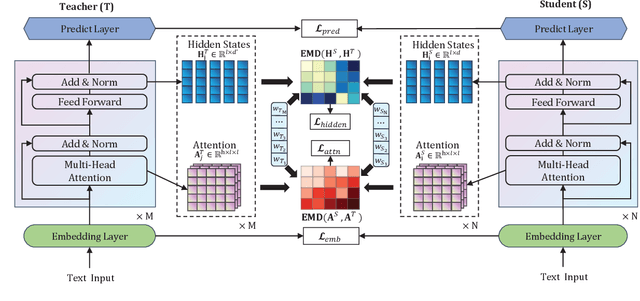
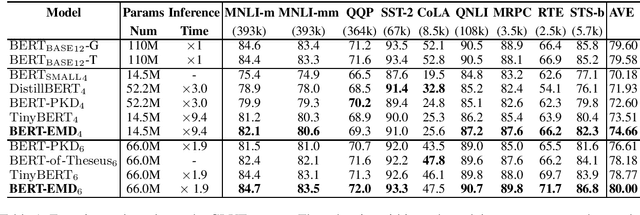
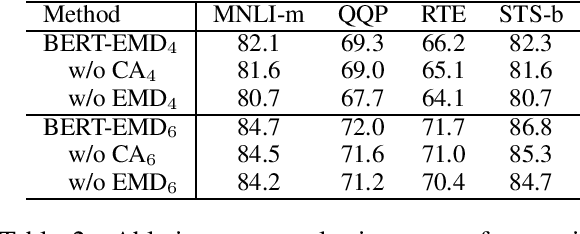
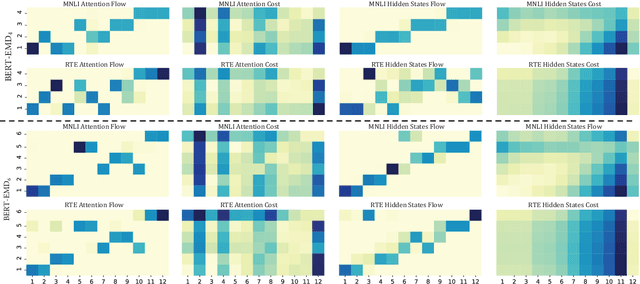
Abstract:Pre-trained language models (e.g., BERT) have achieved significant success in various natural language processing (NLP) tasks. However, high storage and computational costs obstruct pre-trained language models to be effectively deployed on resource-constrained devices. In this paper, we propose a novel BERT distillation method based on many-to-many layer mapping, which allows each intermediate student layer to learn from any intermediate teacher layers. In this way, our model can learn from different teacher layers adaptively for various NLP tasks. %motivated by the intuition that different NLP tasks require different levels of linguistic knowledge contained in the intermediate layers of BERT. In addition, we leverage Earth Mover's Distance (EMD) to compute the minimum cumulative cost that must be paid to transform knowledge from teacher network to student network. EMD enables the effective matching for many-to-many layer mapping. %EMD can be applied to network layers with different sizes and effectively measures semantic distance between the teacher network and student network. Furthermore, we propose a cost attention mechanism to learn the layer weights used in EMD automatically, which is supposed to further improve the model's performance and accelerate convergence time. Extensive experiments on GLUE benchmark demonstrate that our model achieves competitive performance compared to strong competitors in terms of both accuracy and model compression.
 Add to Chrome
Add to Chrome Add to Firefox
Add to Firefox Add to Edge
Add to Edge